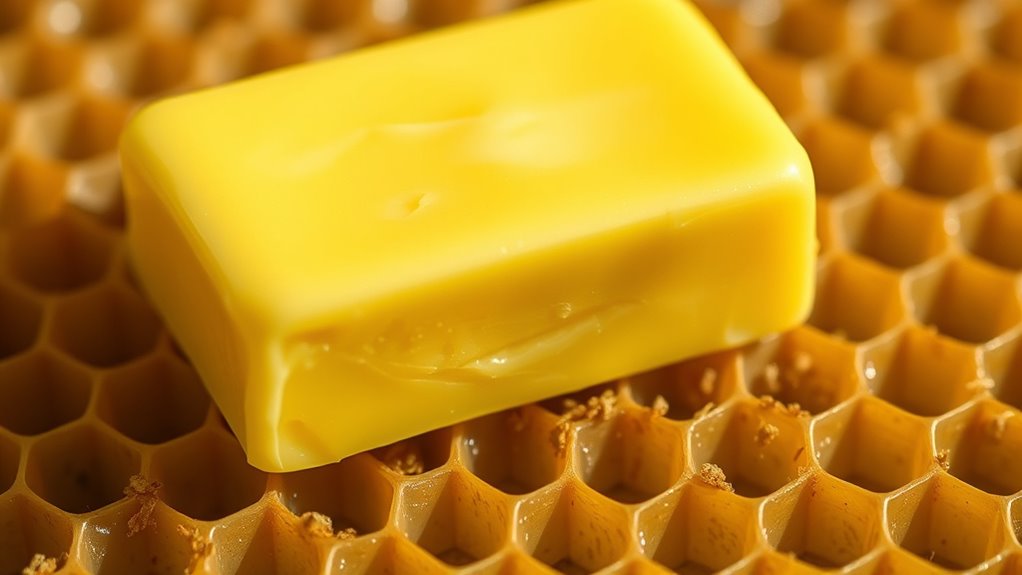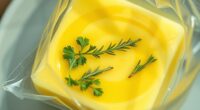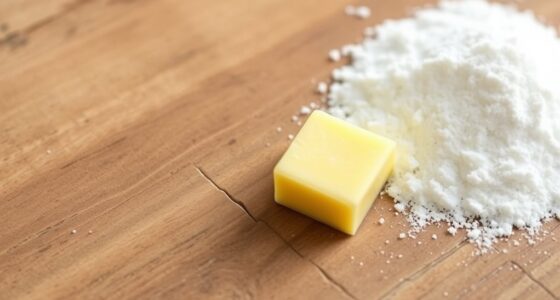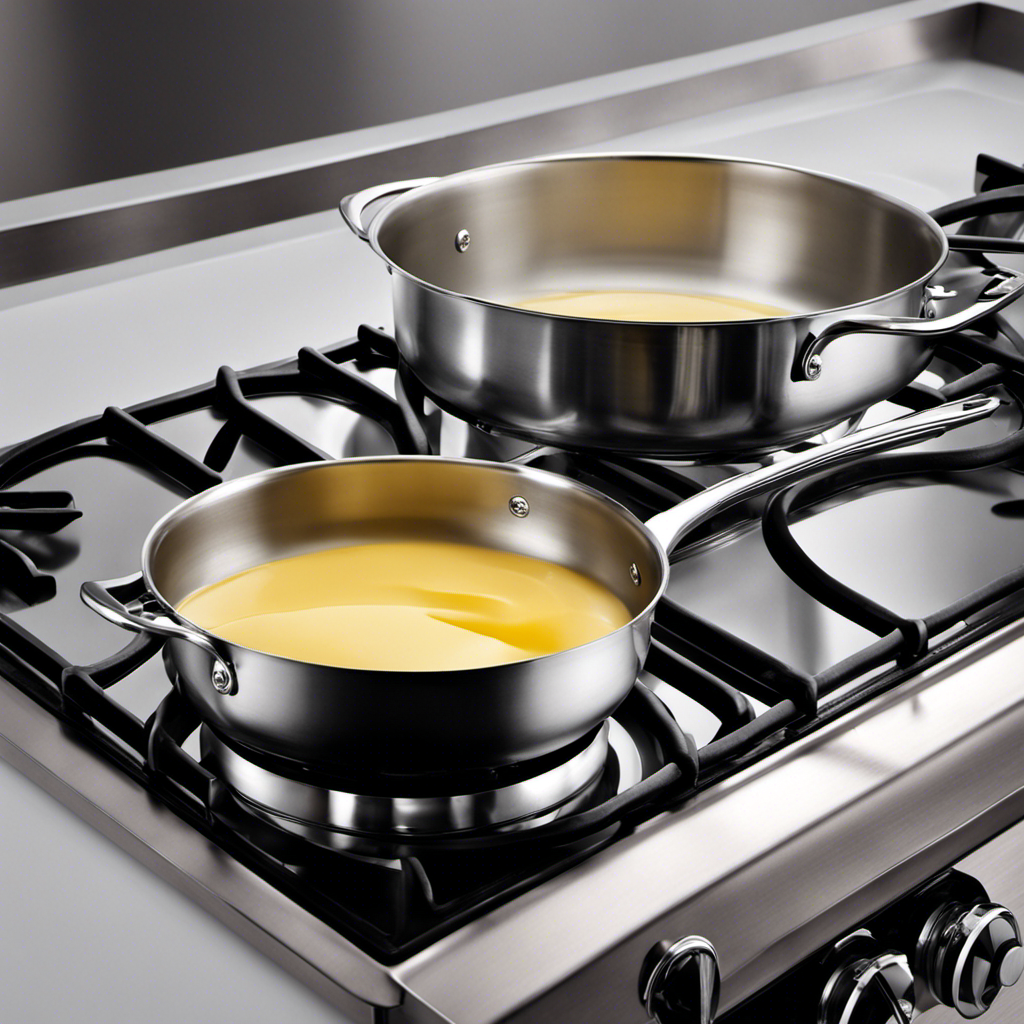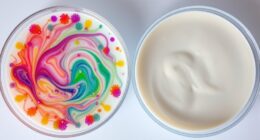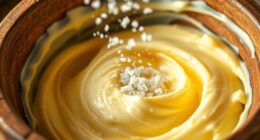Using butter as a pollen trap in your car isn’t a good idea. It might stick to some pollen initially, but it’s neither effective nor safe. Butter can create messy residues, attract dust, and even pose fire hazards due to its flammability and melting. Plus, it won’t match the performance of dedicated filters. To learn safer and more effective ways to reduce pollen exposure, keep going.
Key Takeaways
- Butter’s sticky texture may trap some pollen but lacks scientific validation for effective allergen reduction.
- It poses safety risks like fire hazards, slippery surfaces, and difficulty cleaning inside vehicles.
- Residual butter can damage car interiors and emit odors, potentially worsening air quality.
- Commercial pollen filters are specifically designed and proven more effective than butter-based methods.
- Experts recommend proper cleaning and air filtration over unproven, food-based solutions like butter.
Understanding Pollen Adhesion and Its Challenges
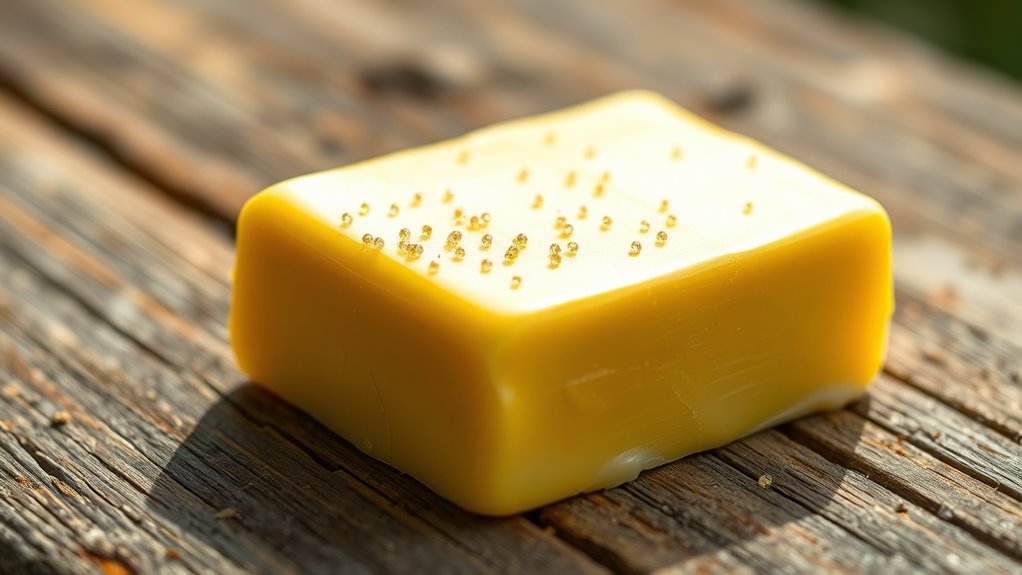
Understanding how pollen sticks to surfaces is essential when evaluating different pollen trapping methods. Pollen surface properties greatly influence adhesion strength, which determines how easily pollen particles cling or detach. Some surfaces promote strong adhesion due to their texture or chemical makeup, making them effective for trapping pollen. Others have weaker adhesion, causing pollen to slide off or blow away easily. When considering a trapping method, you need to understand how pollen interacts with the surface material. For example, smooth surfaces may reduce adhesion strength, while rough or sticky ones enhance it. Recognizing these differences helps you choose or design surfaces that maximize pollen capture, especially in environments like cars where airflow and surface properties impact pollen accumulation. Additionally, the choice of materials used in modular homes or innovative tiny house designs can influence how surface properties affect environmental interactions.
The Science Behind Using Sticky Substances to Capture Allergens

Sticky substances work by trapping allergens through their adhesive properties, preventing them from becoming airborne. Butter’s stickiness may help capture pollen and other particles, but its effectiveness depends on how well it adheres to these allergens. Understanding these mechanisms can reveal whether such substances are practical for allergen control. Incorporating knowledge about comfort solutions can also inform how to improve the application and removal process for better allergen trapping.
Adhesive Properties of Butter
Butter’s adhesive qualities stem from its unique composition, which allows it to cling effectively to airborne particles like pollen. Its dairy viscosity ensures it remains sticky enough to trap particles without immediately sliding off. When exposed to air, butter’s melting point causes it to soften, increasing its stickiness and enhancing pollen capture. Additionally, sound design techniques such as layering and manipulation can be used to simulate or analyze the adhesion process in experimental settings. The key is balancing butter’s viscosity and melting behavior to maintain adhesion.
Allergen Capture Mechanisms
The effectiveness of using substances like butter to trap airborne allergens relies on their ability to adhere to pollen particles as they float through the air. Pollen adhesion occurs when allergen particles come into contact with sticky surfaces, allowing them to bind securely. This allergen binding process depends on the surface properties of the substance, such as stickiness and chemical compatibility, which enable pollen grains to stick effectively. When you apply a sticky substance like butter, it creates a physical barrier that captures pollen before it reaches your respiratory system. The key is maintaining sufficient adhesion to prevent pollen from bouncing off or bypassing the trap. Additionally, the surface properties of the trapping substance, including texture and chemical composition, play a critical role in its ability to effectively capture pollen grains. Understanding these allergen capture mechanisms helps evaluate whether butter or similar substances can serve as practical pollen traps in real-world scenarios.
Efficacy of Sticky Substances
Understanding how sticky substances capture allergens involves examining their adhesion properties. These substances rely on their tackiness to trap pollen particles effectively, preventing them from dispersing. The sticky surface enhances pollen adhesion, ensuring allergens stick firmly upon contact. This mechanism can markedly reduce airborne pollen levels in your environment, offering relief from car allergies. Additionally, choosing a high-quality adhesive can improve overall effectiveness and durability of the pollen trap.
Why Some People Consider Butter as a Pollen Trap
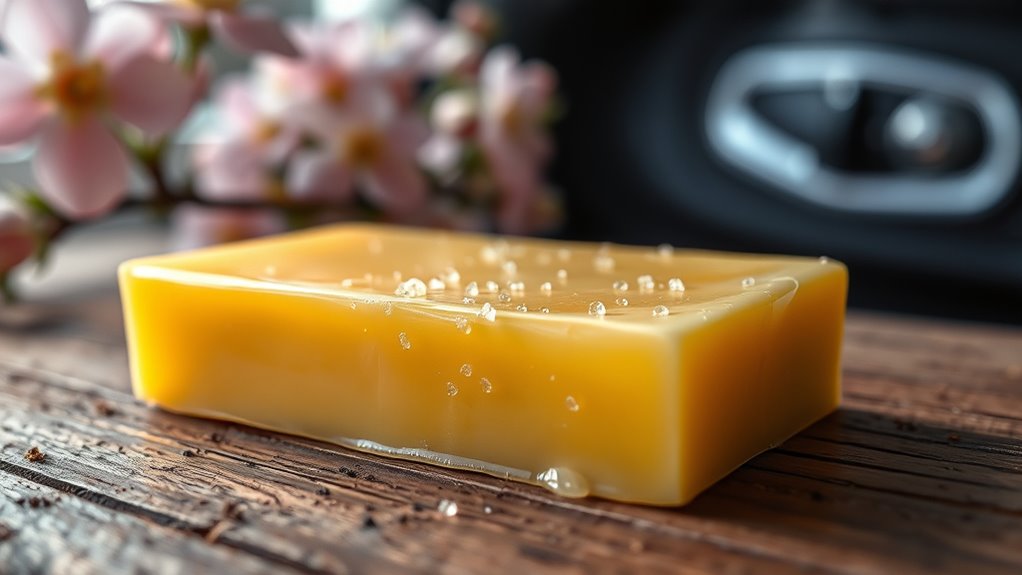
Some people believe that applying butter to the nostrils can trap pollen particles before they reach your nasal passages. The idea is that butter’s sticky texture promotes pollen adhesion, helping to prevent allergen capture deeper inside your nose. Supporters claim that this simple method reduces allergy symptoms during outdoor activities. They argue that butter acts as a barrier, catching pollen grains before they can cause irritation. Additionally, the sticky consistency of butter may influence how effectively it traps pollen particles on contact. While scientific evidence is limited, some see butter as a potential homemade solution for pollen trapping, hoping it can reduce allergen exposure and minimize allergy flare-ups.
Practicality and Safety Concerns of Applying Butter in Cars
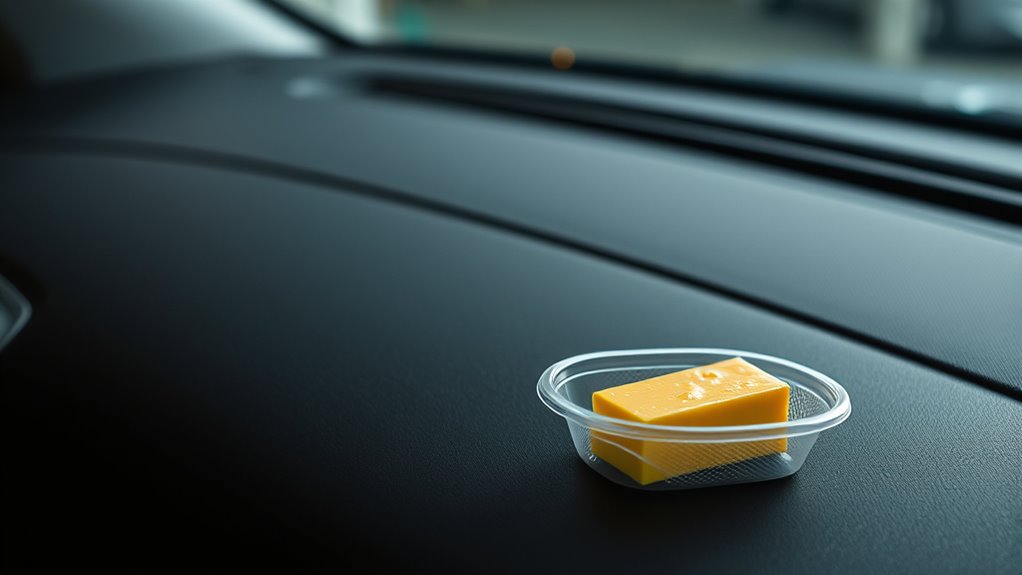
Applying butter in your car raises serious safety concerns, like the risk of starting a fire. It also leaves behind sticky residue and mess that can be hard to clean. Plus, there’s little evidence to confirm whether butter actually works effectively as a pollen trap. Additionally, using unconventional materials like butter may not align with recommended precious metals investment strategies or best practices for maintaining vehicle safety.
Fire Hazard Risks
Using butter as a pollen trap inside a car introduces significant fire hazards that can’t be overlooked. Butter’s flammability poses risks when exposed to heat sources or electrical sparks. Its sticky nature may cause it to smear onto surfaces, increasing the chance of accidental ignition. Additionally, butter’s tendency to melt can lead to allergen adhesion on car fabrics or surfaces, creating difficult cleanup and potential fire risks.
- Butter can catch fire if exposed to heat, especially during hot days or near electrical components.
- Melting butter creates slippery surfaces, increasing accident risks.
- Accumulated allergen adhesion can ignite if exposed to sparks or flames.
These hazards make butter an unsafe choice, especially considering the fire risks associated with its use inside vehicles.
Residue and Mess
Given butter’s sticky and greasy nature, it quickly leaves behind a troublesome residue that’s difficult to clean and may damage your car’s interior. When applied, butter traps pollen, but it also creates a persistent pollen residue that’s hard to remove. This residue can turn into a greasy mess, making your car look dirty and attracting dust and dirt. Cleaning butter from fabric seats or plastic surfaces requires strong cleaners and effort, risking damage to delicate materials. Plus, the mess isn’t just superficial; it can clog vents or damage electronics if not cleaned properly. Overall, while butter might trap pollen, its tendency to create a sticky car mess and residue makes it impractical and potentially risky for your vehicle’s safety and cleanliness. Additionally, using substances like butter as a pollen trap can interfere with the effectiveness of skincare routines, which rely on proper maintenance and clean surfaces to work optimally.
Effectiveness Uncertainties
While butter’s sticky properties can trap pollen, questions about its overall effectiveness and safety remain. You might wonder if it truly improves allergen capture or just creates a mess. Concerns include:
- Whether butter effectively enhances pollen adhesion on car surfaces
- If it captures enough allergens to make a difference for allergy sufferers
- The safety risks of applying and removing butter in a vehicle environment
These uncertainties mean you could end up with limited pollen removal or damage to your car’s interior. The practicality of using butter hinges on consistent allergen capture without causing new problems. Until more research confirms its effectiveness, relying on butter as a pollen trap remains questionable, especially considering safety and long-term safety concerns.
Comparing Butter to Commercial Pollen Filters and Traps

Although butter has been suggested as a natural pollen trap, it doesn’t perform as effectively as commercial pollen filters and traps. Commercial filters are designed to maximize pollen adhesion by using specialized materials that attract and capture allergens efficiently. They often have tightly woven fibers or activated carbon layers that improve allergen adhesion, reducing pollen levels inside your car. Butter, on the other hand, lacks this engineered structure, making it less effective at trapping pollen particles. Its sticky surface may temporarily catch some pollen, but it doesn’t provide consistent or reliable allergen adhesion. Additionally, preppy dog names are often used for dogs with a refined appearance, but they are not relevant to pollen trapping. As a result, butter isn’t a practical alternative, especially when compared to the proven capabilities of commercial pollen filters and traps that are specifically designed for allergen control.
Potential Effects of Butter on Car Interiors and Air Quality

Applying butter as a pollen trap inside your car can negatively impact both the interior environment and air quality. Butter may cause unwanted buildup of residue, attracting pollen and other allergens through pollen adhesion and allergen adhesion. This sticky layer can trap dust, dirt, and pollutants, worsening air quality over time. The residue can also damage interior surfaces, leading to stubborn stains and deterioration of materials. Additionally, decomposing butter releases odors and volatile compounds, which can circulate through your ventilation system. Portable camping solutions emphasize the importance of maintaining clean and allergen-free environments to ensure comfort and health. – Promotes the accumulation of dirt and allergens on surfaces – Causes unpleasant odors that linger in the cabin – Potentially damages upholstery and dashboard materials
Expert Opinions on Using Food Products for Allergen Control
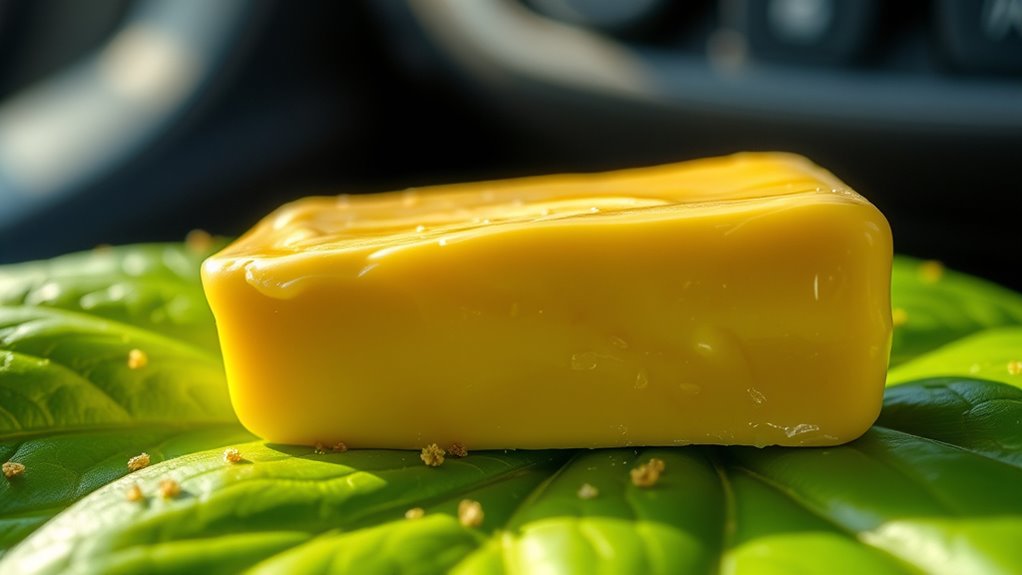
Experts generally advise against using food products like butter as allergen control methods in vehicles. They warn that butter can introduce dairy allergens, which pose risks to individuals with dairy allergies. Relying on cooking techniques or food substances to trap pollen isn’t effective or safe. Instead, allergen control focuses on proper cleaning and air filtration. Experts emphasize that attempting to use butter or similar products may worsen allergen exposure, especially if residues remain. They stress that managing car allergies requires proven methods rather than unproven, potentially hazardous, food-based solutions. Ultimately, health professionals recommend avoiding food products as pollen traps, emphasizing the importance of targeted cleaning and air quality measures to protect allergy sufferers.
Alternative Natural Methods for Reducing Pollen Exposure in Vehicles
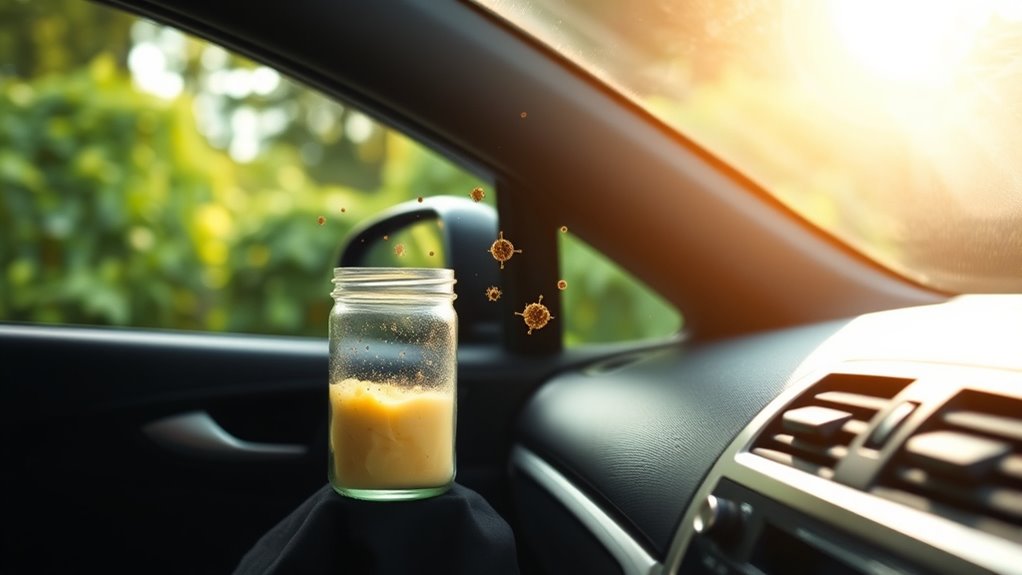
To naturally reduce pollen exposure in your vehicle, consider using air purifying plants or natural ionizers that can help trap airborne allergens. These natural remedies work by reducing pollen adhesion to surfaces and clearing the air of pollen particles. Incorporate items like:
Using air purifying plants and natural ionizers can help reduce pollen in your vehicle naturally.
- Small potted plants such as aloe vera or jasmine that produce natural air purification effects.
- Natural ionizers or essential oil diffusers that emit ions to neutralize pollen particles.
- Activated charcoal filters or DIY air purifiers to absorb pollen and reduce allergen buildup.
These methods can effectively lower pollen levels inside your vehicle without relying on chemicals or synthetic products. Using natural remedies allows you to create a cleaner environment and reduce allergy symptoms, providing a practical, eco-friendly approach to managing pollen exposure while on the road.
Recommendations for Effective Allergy Management While Driving
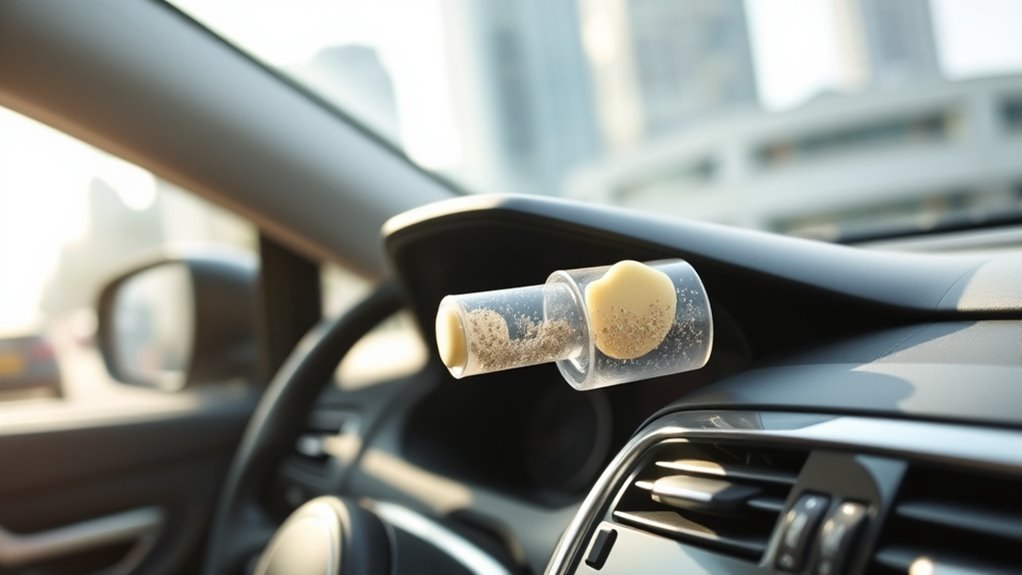
When you’re behind the wheel during peak pollen seasons, taking proactive steps can make a significant difference in managing allergy symptoms. To reduce pollen adhesion, keep windows closed and use an air purifier with a HEPA filter. Regularly clean your vehicle’s interior to remove trapped pollen. While butter properties are sometimes discussed, avoid applying it to your skin or surfaces, as it doesn’t prevent pollen adhesion and could create more mess. Instead, focus on wearing a pollen mask and taking antihistamines if necessary. Stay hydrated and plan routes avoiding high pollen areas when possible. Proper ventilation and cleanliness are your best tools. These measures help minimize pollen exposure and keep allergy symptoms under control during your drive.
Frequently Asked Questions
Has Anyone Successfully Used Butter to Reduce Pollen in Cars?
You might wonder if butter can help reduce pollen in your car. Based on DIY experiments and user experiences, butter isn’t effective as a pollen trap. People have tried it out of curiosity, but it doesn’t trap pollen particles well and can create messes. Instead, consider using specialized pollen filters or regular cleaning. Butter isn’t a practical solution, so it’s better to stick with proven methods for managing car allergies.
Is There Scientific Evidence Supporting Butter as an Effective Pollen Trap?
Thinking about butter as a pollen trap is like trying to catch raindrops with a net made of cheese. Current scientific evidence doesn’t support butter’s effectiveness in reducing pollen adhesion or allergen levels in cars. While it might seem clever, butter isn’t designed to trap pollen particles. Instead, rely on proven methods like air purifiers or regular cleaning to genuinely reduce pollen exposure and improve allergy symptoms.
What Are the Potential Health Risks of Applying Butter in Vehicles?
Applying butter in your vehicle can cause skin irritation, especially if it contacts your skin directly. It also increases the risk of allergy flare-ups because butter can trap dust and pollen, which may worsen allergies. Plus, butter’s greasy nature could attract dirt and bacteria, leading to unpleasant odors and potential health issues. Overall, using butter in your car isn’t safe and might make allergy symptoms worse.
How Does Butter Compare to Traditional Pollen Filtering Methods?
Imagine trying to catch tiny dancers in a net—now picture butter as that net. Butter isn’t a great choice for trapping pollen because its adhesion is weak, leading to poor trapping effectiveness. Unlike traditional filters designed for pollen adhesion, butter fails to trap pollen effectively, letting allergens slip through. You’d be better off sticking with proven pollen filters that truly capture airborne particles, ensuring cleaner, allergy-free air in your vehicle.
Are There Environmentally Friendly Alternatives to Butter for Pollen Trapping?
You’re exploring environmentally friendly options for pollen trapping, so plant-based solutions and biodegradable options are great choices. Instead of butter, consider using natural substances like soy-based or other plant-derived materials that trap pollen effectively. These biodegradable options break down safely, reducing environmental impact. By choosing these alternatives, you can efficiently trap pollen while supporting sustainability efforts and minimizing harm to the environment.
Conclusion
While butter might seem like a simple solution, it’s not practical or safe. It won’t effectively trap pollen, it can damage your car’s interior, and it poses health risks. Instead, focus on proven methods like high-quality filters, regular cleaning, and staying informed. Protect your health, improve your comfort, and guarantee your car’s cleanliness. Choose reliable solutions, prioritize safety, and keep pollen outside where it belongs, not on your dashboard or in your lungs.
